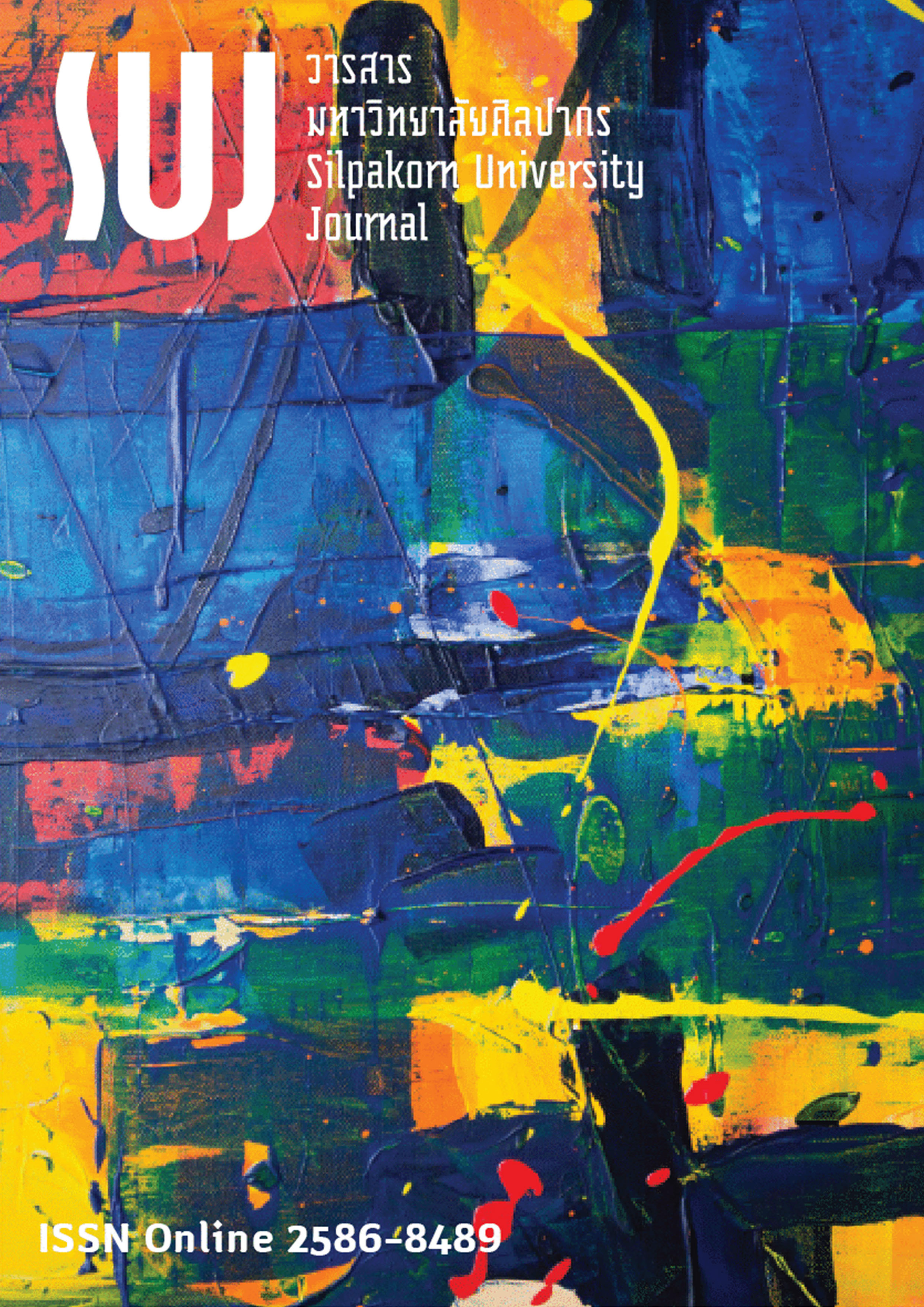การสื่อสารตราสินค้าผลิตภัณฑ์เครื่องดื่มแอลกอฮอล์ที่ปรากฏบนสื่อสังคมออนไลน์ในสังคมไทย (Alcohol brand communications on social media in Thai society)
Main Article Content
Abstract
บทความวิจัยชิ้นนี้มีวัตถุประสงค์เพื่อศึกษากลยุทธ์และรูปแบบเนื้อหาการสื่อสารตราสินค้าผลิตภัณฑ์เครื่องดื่มแอลกอฮอล์ที่ประกอบสร้างผ่านสื่อสังคมออนไลน์ในสังคมไทยในปี 2562 โดยการวิเคราะห์เนื้อหาด้วยวิธีวิจัยเชิงคุณภาพของเนื้อหาที่โพสต์บนเฟซบุ๊คแฟนเพจของตราสินค้าแอลกอฮอล์ยอดนิยมในสังคมไทย โดยพิจารณาความนิยมจากยอดผู้ติดตาม ได้แก่ ช้างเวิลด์ สิงห์คอร์ปเปอเรชั่น และเมอริเดียนบรั่นดี รวมจำนวนการโพสต์ทั้งสิ้น 1,038 โพสต์ ผลการศึกษาพบว่า กลยุทธ์การสื่อสารตราสินค้าด้านผลิตภัณฑ์ที่เน้นการสร้างแรงดึงดูดด้านอารมณ์และการส่งเสริมการตลาดที่เน้นการจัดกิจกรรมทางการตลาด คือ 2 กลยุทธ์สำคัญที่ผู้ประกอบการใช้มากที่สุดในช่วงเวลาดังกล่าว ช้างและสิงห์ คือ 2 ตราสินค้าที่ทำการสื่อสารบนสื่อสังคมออนไลน์มากที่สุดในช่วงเวลาดังกล่าว ในส่วนของรูปแบบเนื้อหาที่ประกอบสร้างความหมายตราสินค้านั้น พบว่า แต่ละตราสินค้ามีความแตกต่างอย่างเห็นได้ชัด กล่าวคือ ช้างเน้นสร้างเนื้อหาที่สะท้อนความสนุกและมิตรภาพระหว่างเพื่อนเพื่อดึงดูดกลุ่มเป้าหมายวัยรุ่นผ่านกิจกรรมดนตรีและกีฬา ในขณะที่สิงห์เน้นเนื้อหาที่เกี่ยวกับการสร้างแรงบันดาลใจ การทำงานหนักเพื่อความสำเร็จในชีวิตและการรับผิดชอบต่อสังคมเพื่อสร้างภาพลักษณ์องค์กร สื่อสารกับกลุ่มเป้าหมายผู้ใหญ่วัยทำงาน องค์ความรู้ที่ได้จากการศึกษาครั้งนี้สามารถนำไปปรับใช้ในการศึกษาการสื่อสารตราสินค้าผลิตภัณฑ์เครื่องดื่มแอลกอฮอล์ การสร้างบุคลิกภาพตราสินค้า การประกอบสร้างความหมายสัญญะตราสินค้า และตำแหน่งของตราสินค้า เพราะสังคมไทยสินค้าแอลกอฮอล์เป็นกลุ่มสินค้าควบคุมและขัดต่อศีลธรรมศาสนาพุทธซึ่งเป็นศาสนาประจำชาติ การสื่อสารการตลาดสินค้าชนิดนี้จึงมีความเฉพาะและแตกต่างจากสินค้าทั่วไป
This research article explored strategies and content formats of alcohol brand communications on social media in Thai society in 2019. This qualitative research analyzed the content of alcohol brands as posted on popular Facebook Fan Pages in Thai society. The total number of posts from Chang World, Singha Corporations, and Meridian Brandy Facebook Fan Pages was 1,038. The study found that the two crucial and most used brand communication strategies were creating emotional branding and marketing promotions through various marketing activities. Moreover, “Chang” and “Singha” were the two brands that communicated the most on social media during that time. As for the content formats, it was found that each brand had unique and different content forms and positioning. For example, “Chang” focused on content about fun and friendship to attract teenagers through music and sports activities while “Singha” emphasized inspirational content such as hard work as a key to success and CSR to build a corporate image and to communicate with working adults. The knowledge gained from this study could be applied to alcohol brand communication studies, brand personality building, logo construction, and brand positioning. Since in Thailand alcoholic beverages are controlled products and are against the morality of Buddhism, alcohol brand communication and marketing are therefore unique and different from other products.
Downloads
Article Details

This work is licensed under a Creative Commons Attribution-NonCommercial-NoDerivatives 4.0 International License.
References
Aaker, D. A. (2009). Managing Brand Equity. New York: Simon & Schuster Inc.
Arnould, E. J., & Thompson, C. J. (2005). Consumer culture theory (CCT): Twenty years of research. Journal of Consumer Research, 31(4): 868-882.
Azar, S. L., Machado, J. C., Vacas-de-Carvalho, L., & Mendes, A. (2016). Motivations to interact with brands on Facebook-Towards a typology of consumer-brand interactions. Journal of Brand Management, 23(2): 153-178.
Babor, T., Caetano, R., Casswell, S., Edwards, G., Giesbrecht, N., Graham, K., Grube, J., Hill, L., Holder, H., Homel, R., Livingston, M., Österberg, E., Rehm, J., Room, R., & Rossow, I. (2010). Alcohol : No Ordinary Commodity : Research and Public Policy (2nd ed.). Oxford: Oxford University Press.
Belch, G. E., & Belch, M. A. (2012). Advertising and Promotion : An Integrated Marketing Communications Perspective (9th ed.). New York: McGraw-Hill.
Belk, R. W. (1988). Possessions and the extended self. Journal of Consumer Research, 15(2): 139-168.
Braun, V., & Clarke, V. (2006). Using thematic analysis in psychology. Qualitative Research in Psychology, 3(2): 77-101.
Chaiprasit, Chanchai. (2021). Consumer Insight in Thailand During Covid-19 (เจาะพฤติกรรมผู้บริโภคไทยที่เปลี่ยนไปในยุคโควิด-19). [Online]. Retrieved December 11, 2021 from https://thestandard.co/thai-consumer-behavior-during-the-covid-19-era/
Department of Disease Control, Ministry of Public Health. (2021). The Department of Disease Control Thailand explains the controversial issue about posting the figures of alcohol products online (กรมควบคุมโรคชี้แจงประเด็นการแชร์ข้อมูลเกี่ยวกับการโพสต์รูปเครื่องดื่มแอลกอฮอล์ลงสื่อสังคมออนไลน์). [Online]. Retrieved December 13, 2021 from https://ddc.moph.go.th/oabc/news.php?news=13485
Elliott, R., & Wattanasuwan, K. (1998). Brands as symbolic resources for the construction of identity. International Journal of Advertising, 17(2): 131-144.
Euromonitor International. (2020). Consumer Lifestyles in Thailand. [Online]. Retrieved December 10, 2021 from https://www.euromonitor.com/consumer-lifestyles-in-thailand/report
Gee, S., & Jackson, S. J. (2012). Leisure corporations, beer brand culture, and the crisis of masculinity: the speight’s ‘Southern Man’ advertising campaign. Leisure Studies, 31(1): 83-102.
Goldman, R. (1992). Reading Ads Socially. London: Routledge.
Gunter, B., Hansen, A., & Touri, M. (2010). Alcohol Advertising and Young People’s Drinking: Representation, Reception and Regulation. London: Palgrave Macmillan.
Jernigan, D. H. (2009). The global alcohol industry: An overview. Addiction, 104(Suppl. 1): 6-12.
Keller, K. L. (2012). Strategic Brand Management: Building, Measuring, and Managing Brand Equity (4th ed.). Boston: Pearson.
Kemp, s. (2021). Digital 2021: Thailand. [Online]. Retrieved December 14, 2021 from https://datareportal.com/reports/digital-2021-thailand
Kotler, P. (1991). Principles of Marketing (5th ed.). New York: Prentice Hall International.
Kotler, P., & Armstrong, G. (2010). Principles of Marketing. New York: Pearson Prentice Hall.
Kotler, P., Kartajaya, H., & Setiawan, I. (2018). Marketing 4.0: Moving from Traditional to Digital. Hoboken, NJ: John Wiley & Sons.
Kotler, P., Kartajaya, H., & Setiawan, I. (2021). Marketing 5.0: Technology for Humanity. Hoboken, NJ: John Wiley & Sons.
Noel, J. K., Sammartino, C. J., & Rosenthal, S. R. (2020). Exposure to digital alcohol marketing and alcohol use: A systematic review. Journal of Studies on Alcohol and Drugs, 19(Suppl.): 57-67.
Roonkaseam, Nitta. (2019). Alcoholic beverages’ sales promotion strategies of the alcohol business group in Thailand (กลยุทธ์การส่งเสริมการขายผลิตภัณฑ์เครื่องดื่มแอลกอฮอล์ของกลุ่มธุรกิจแอลกอฮอล์ในประเทศไทย). CRRU Journal of Communication Chiangrai Rajabhat University, 2(3): 1-25.
Sinsuwarn, Natwipa. (2010). Textual Analysis and Decoding of Symbolic Meaning of Alcoholic Beverage Advertisements in Thai Society (การวิเคราะห์ตัวบทและการถอดรหัสความหมายเชิงสัญญะของโฆษณาเครื่องดื่มแอลกอฮอล์ในสังคมไทย). Doctoral dissertation, Chulalongkorn University, Bangkok, Thailand.
Sinsuwarn, Natwipa. (2015). Marketing mix communication strategies of the online media of alcohol industries in Thai society (กลยุทธ์การสื่อสารผ่านส่วนผสมทางการตลาดบนสื่อออนไลน์ของธุรกิจเครื่องดื่มแอลกอฮอล์ในสังคมไทย). Academic Journal of Humanities and Social Sciences Burapha University, 23(43): 171-195.
Siripai, Jhitsayarat. (2021). Branding, masculinities and culture: Exploring the branding of alcohol product representations in Thailand. The Journal of Men’s Studies, 29(2): 156-176.
Statista. (2021). Media Industry Spending Estimate: Thailand 2021. [Online]. Retrieved December 10, 2021 from https://www.statista.com/statistics/586751/thailand-ad-spend-estimate-medium/
Sunthornchuen, Wirawat, & Sinthupinyo, Sukree. (2018). Words Diffusion an Analysis of Across Facebook Pages in Thailand. In Proceedings of 2018 10th International Conference on Electronics, Computers and Artificial Intelligence (ECAI), (pp. 1-5). Iasi, Romania: IEEE.
Towns, A. J., Paker, C., & Chase, P. (2012). Construction of masculinity in alcohol advertising: Implications for the prevention of domestic violence. Addiction Research and Theory, 20(5): 389-401.
Tybout, A. M., & Calkins, T. (2019). Kellogg on Branding in a Hyper-Connected World. Hoboken, NJ: John Wiley & Sons.
Wattanasuwan, Kritsadarat. (2005). The self and symbolic consumption. Journal of American Academy of Business, 6(1): 179-184.
Wernick, A. (1991). Promotional Culture: Advertising, Ideology and Symbolic Expression. London: Sage Publications.
Witvorapong, Nopphol, Ratisukpimol, Watcharapong, & Watanapongvanich, Somtip. (2019). Effectiveness of alcohol-prevention social marketing in the presence of alcohol advertising. Journal of Social Marketing. 9(3): 309-328.


